15 Types of Blackbirds in Kentucky (With Pictures)
Last Updated on

Out of the 25 New World blackbirds in North America, 15 are found just in Kentucky, where most blackbirds spend their winters. Eleven of these species are regularly occurring. Meanwhile, others are considered rare, accidental, and threatened.
Kentucky has a wide variety of blackbirds. That includes the European Starling, Rusty Blackbird, Bobolink, Eastern Meadowlark, and more. The state’s active birdwatching community maintains available and full bird feeders. As a result, most birds prefer to stay here year-round.
Here’s everything to learn about the blackbirds of Kentucky.

1. European Starling
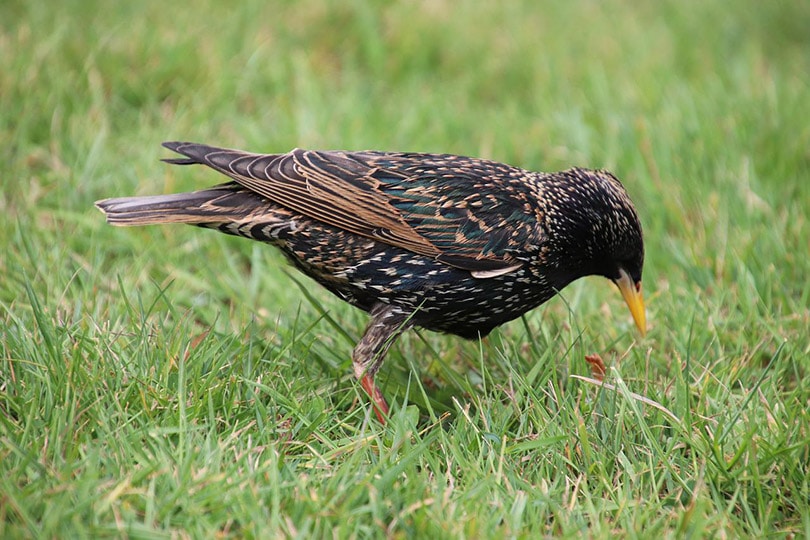
| Scientific Name | Sturnus vulgaris |
| Weight | 0.21 pounds |
| Wingspan | 15.8 inches |
| Lifespan | 3 years |
| Diet | Insects, berries, fruits, and seeds |
The European Starling resides year-round in the fields, wooded areas, and dense forests of Kentucky. Their small body features black and iridescent feathers with white edges. The varying shades of purple, black, and blue give the bird a galaxy-like appearance.
Moreover, their yellow beaks stand bright compared to their red feet and black tips. In most states, European Starlings are considered pests, as they tend to exhibit aggressive behavior and fly in noisy flocks. They feed on various insects and fruits, such as holly berries, mulberries, cherries, seeds, grains, caterpillars, beetles, and flies.
Additionally, sumac, earthworms, spiders, and Virginia Creepers may be part of their diet. Their calls consist of common chatters, warbles, and whistles, but they mimic other birds’ songs instead of singing their own.
The male European Starling builds the base of the nest with pine needles, while the female lines with grass and other soft material. During breeding, a female may lay three to six eggs, which hatch 2 weeks later.
2. Red-winged Blackbird
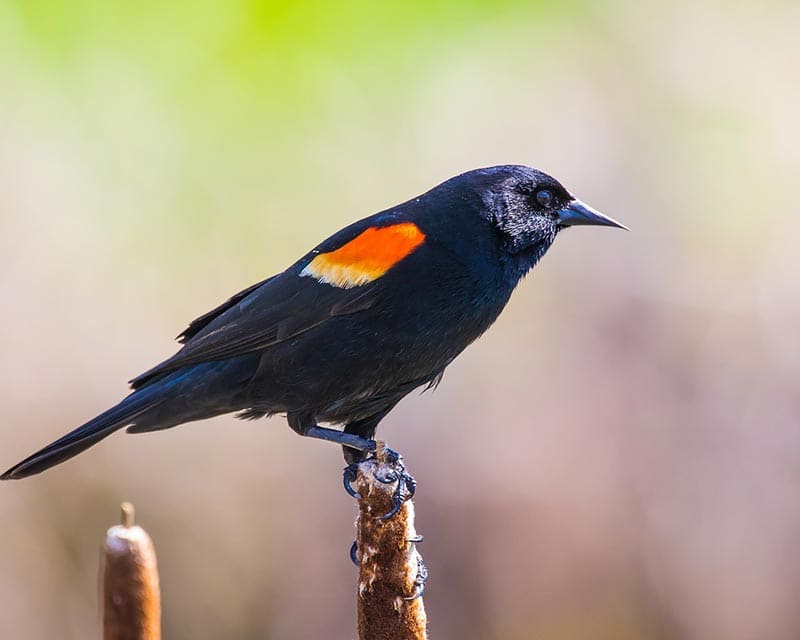
| Scientific Name | Agelaius phoeniceus |
| Weight | 0.16 pounds |
| Wingspan | 15.8 inches |
| Lifespan | 15 years |
| Diet | Seeds and suet |
The Red-winged Blackbird migrates to the southeastern state of Kentucky in the winter after spending the breeding season in northern states such as New York. Their feathers are nearly all black, except for their bright red and yellow shoulders.
Compared to the male Red-winged Blackbird, its female counterpart has an unassuming and plain appearance. Where the male exhibits vibrant hues, the female has darker coloration and white eyebrows. You may find Red-Winged Blackbirds in marshes, fields, meadows, and telephone wires.
Their diet changes seasonally, as they prefer to feed on insects in the summer and seeds and suet in the winter. Their songs and calls are unique, making these birds easy to detect. Keep an ear out for a drawn-out “okelee” sound.
During its breeding season, the male Red-winged Blackbird precariously finds a territory for nesting. Then, the bird defends it aggressively, attacking those near its nests. Finally, the pair builds their nest using stalks and stems near dense vegetation, in which they lay two to four eggs that hatch 2 weeks later.
3. Common Grackle
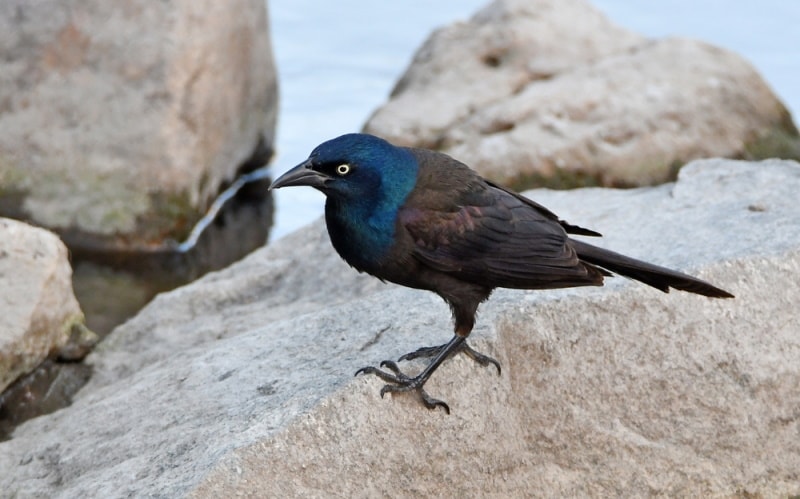
| Scientific Name | Quiscalus quiscula |
| Weight | 0.31 pounds |
| Wingspan | 18.1 inches |
| Lifespan | 22 years |
| Diet | Insects, berries, and seeds |
According to the IUCN Red List, the Common Grackle is a near-threatened species, but you may occasionally spot it in Kentucky during the winter. They migrate to colder states in the summer and spend their breeding season. Their feathers are unlike most birds, offering a glossy and iridescent shade of black that makes them easy to identify.
On its head, the iridescent feathers have a cool blue glow, especially under the sunlight, making it a signature feature of this bird. The Common Grackle prefers residing in marshes, open woodlands, fields, and parks. This indicates their preference for nature without confining themselves to densely wooded areas like other blackbirds.
These birds prefer eating insects, berries, and seeds, but they also settle for any human food they may find in the garbage. To identify a Common Grackle, look for their distinct calls, consisting of whistles, squeaks, and croaks.
4. Brown-headed Cowbird
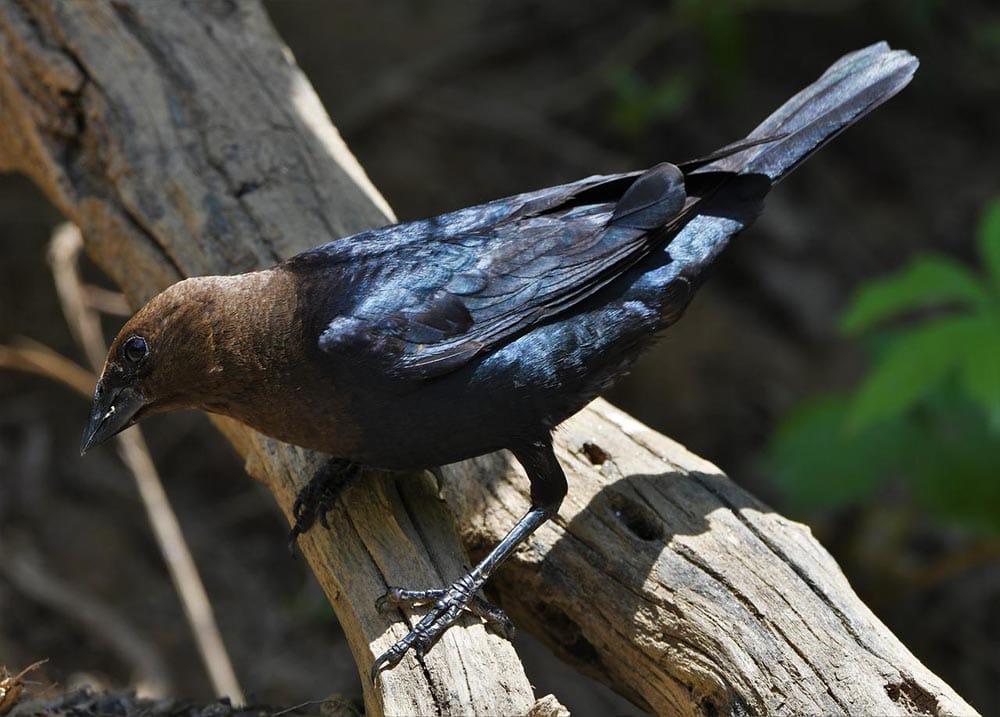
| Scientific Name | Molothrus ater |
| Weight | 0.11 pounds |
| Wingspan | 14.2 inches |
| Lifespan | 17 years |
| Diet | Seeds and insects |
The Brown-headed Cowbird’s appearance is what the name entails, with its brown head being its identifying feature. Other than that, it has a round, black body. Compared to the male Brown-headed Cowbird, the female has a plain appearance: light brown feathers with white streaks.
These birds live in open fields, grasslands, and wooded areas. They feed on insects, grass, weed seeds, and other nutrition found in such areas. The female may occasionally eat eggs with the shell to increase calcium intake.
Recognizing them by their calls is easy, as they have an array of sounds. They occasionally gurgle and whistle in rapid and high-pitched tones, which only last a few seconds.
5. Eastern Meadowlark
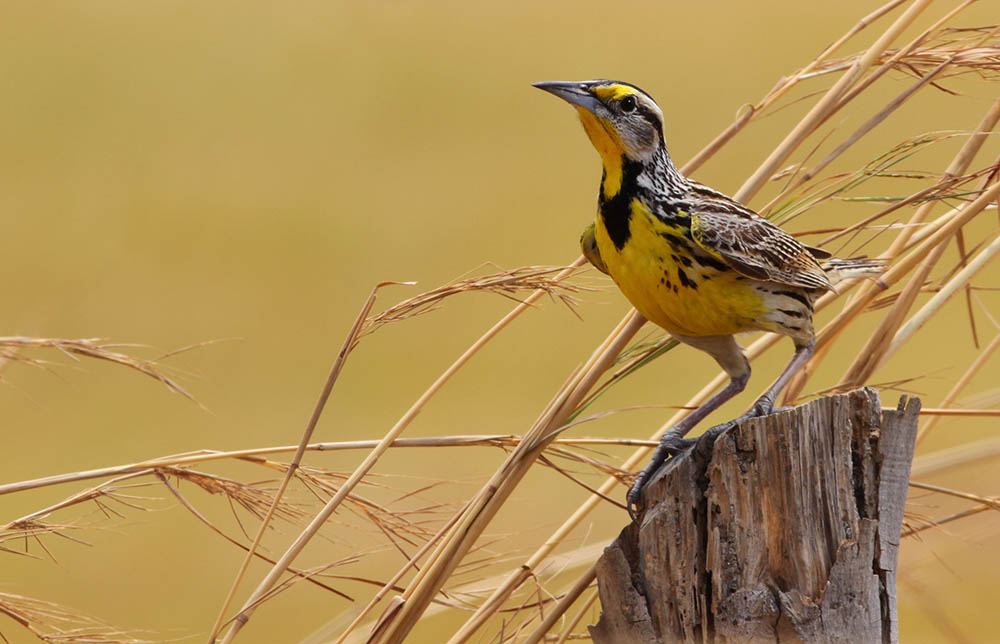
| Scientific Name | Sturnella magna |
| Weight | 0.33 pounds |
| Wingspan | 15.8 inches |
| Lifespan | 5 years |
| Diet | Seeds, waste grain, and insects |
Like the Common Grackle, Eastern Meadowlarks are near-threatened species but are occasionally sighted in Kentucky. They spend most of their winter in Kentucky and other southern states after spending the summer in northern states such as New York.
Luckily, their appearance makes them easy to detect. They have a bright yellow belly and a pale brown back with black marks, but their most recognizable feature is the black band across their chest.
The Eastern Meadowlark’s song signifies the arrival of spring, as you can find them singing in the grasslands, prairies, and meadows of Kentucky. They feed on waste, insects, and seeds in such areas.
Their calls are mostly sharp and melodious whistles, but it’s also worth noting that the Eastern Meadowlark can sing more than 100 songs.
6. Baltimore Oriole

| Scientific Name | Icterus galbula |
| Weight | 0.08 pounds |
| Wingspan | 11.8 inches |
| Lifespan | 14 years |
| Diet | Insects, berries, and nectar |
No bird better indicates its diet with its appearance than the Baltimore Oriole. Their bright orange and black appearance set them apart from other orioles but also resembles their diet. These birds feed on berries, nectar, and insects. They’re big fans of oranges, mulberries, cherries, raspberries, and bananas.
Like most bird pairs, the female counterpart has a duller appearance, with its orange and yellow feathers not as striking as the males. Baltimore Orioles prioritize their solitude, living in forest edges, riverbanks, and open woodlands.
Attracting them to your backyard is as easy as placing some oranges or sugar water, as these birds famously have a sweet tooth. Their signature sounds are flute-like, contrasting their shrill alarm calls.
7. Orchard Oriole
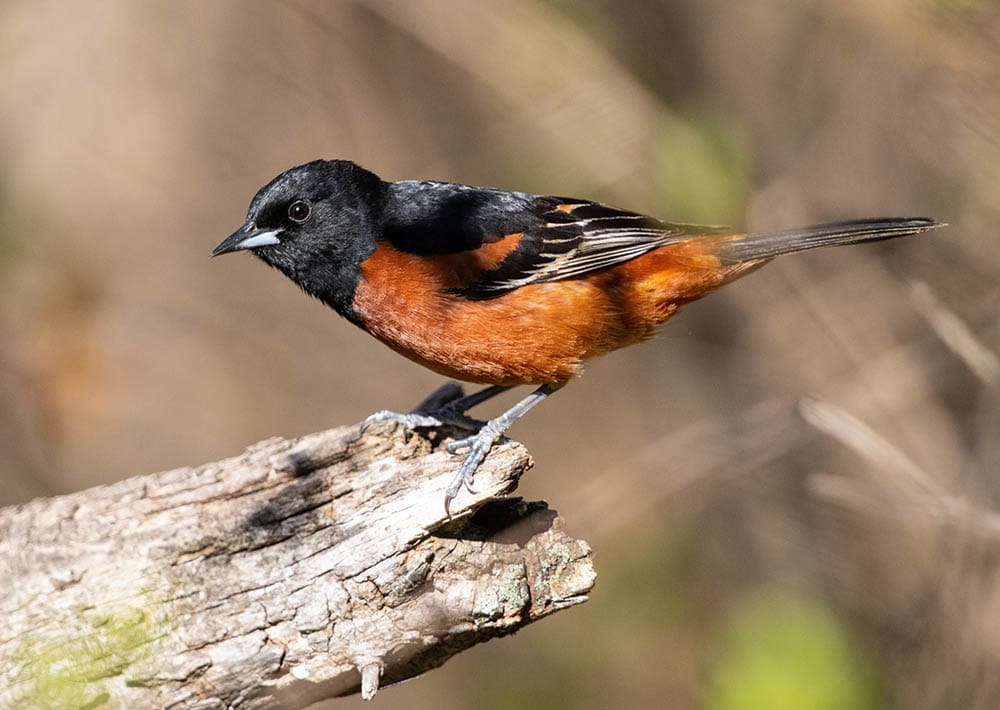
| Scientific Name | Icterus spurius |
| Weight | 0.06 pounds |
| Wingspan | 9.8 inches |
| Lifespan | 11 years |
| Diet | Insects, berries, and nectar |
Winter is the best time to spot Orchard Orioles, most of which arrive in Kentucky in November. They spend the next six months in this warm southeastern state, leaving for colder regions in April.
The male Orchard Oriole is brightly colored, featuring a black back and head. Contrastingly, the female has a lime green bottom half.
Those looking for Orchard Orioles in Kentucky should forage in open woodlands, farms, backyards, riverbanks, and shrublands. Their diet includes berries, insects, and nectar. More specifically, they prefer caterpillars, beetles, grasshoppers, and ants.
If they’re lucky, they may find some flowers to drink nectar from or some chalk and mulberries. Their sounds include jumbled and irregular whistles that last approximately 3 seconds.
8. Rusty Blackbird
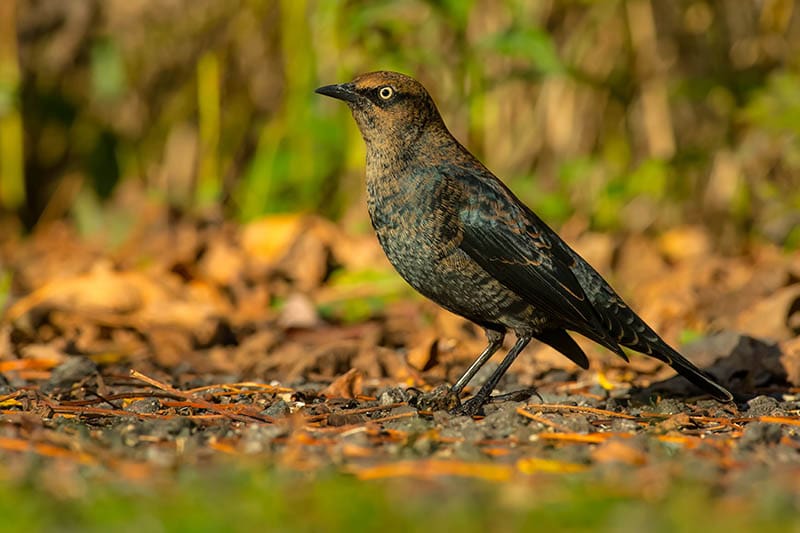
| Scientific Name | Euphagus carolinus |
| Weight | 0.17 pounds |
| Wingspan | 14.6 inches |
| Lifespan | 8 years |
| Diet | Insects and plant matter |
Rusty Blackbirds are vulnerable species that prefer to spend all year in northern states, but you may occasionally spot some in Kentucky during the winter. Their appearance is plain, having black feathers with rusty edges that get even rustier in the winter.
While the male has dark, glossy feathers, its female counterpart is grayish brown with a light streak above their eye. Before migrating to the US, these birds breed in Canada’s boreal forests.
They reside in bogs, marshes, swamps, and large ponds and feed on seeds, insects, plant matter, and fish. Their sounds are easily distinguishable, delivering two to three chips before a high-pitched whistle.
9. Bobolink

| Scientific Name | Dolichonyx oryzivorus |
| Weight | 0.12 pounds |
| Wingspan | 10.6 inches |
| Lifespan | 6 years |
| Diet | Insects and seeds. |
The Bobolink has an unusual name and appearance, which is even easier to identify during the breeding season. The male Bobolink is black, except for its yellow head and white stripes. The pale yellow patch resembles a bald head, contributing to the bird’s strange appearance.
The female had a much more common appearance in dull green, brown, black, and white hues. You may find these birds in open grasslands, perched upon plants, and foraging for insects and seeds.
From April through November, these birds spend their breeding season in Kentucky, building their nests in pairs. These birds nest on the ground while the males exhibit splendid displays to impress females. Their calls include “peek” and “check” sounds in an irregular pattern.
10. Brewer’s Blackbird
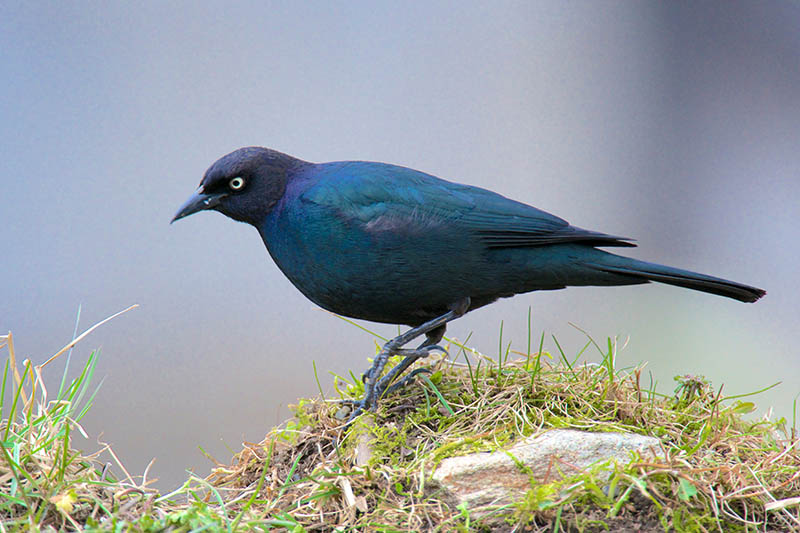
| Scientific Name | Euphagus cyanocephalus |
| Weight | 0.18 pounds |
| Wingspan | 14.6 inches |
| Lifespan | 12 years |
| Diet | Insects, berries, and seeds |
Brewer’s Blackbirds are rarely spotted, offering a once-in-blue-moon sighting in Kentucky. Their last recorded sighting was in 2014. Covered in glossy black feathers, these birds have an iridescent green glow and a distinguishable purple patch.
While searching for a Brewer’s Blackbird, some common sightings are grasslands, coasts, marshes, parks, backyards, meadows, fields, and woodlands. Their diet includes insects, seeds, and berries, along with anything they may find in the garbage.
They build a strong base for their nests with twigs and grass, lining it with softer materials such as soft dry grass and mud. Their calls are unique, consisting of repetitive “chuk” sounds in their short and shrill songs.
11. Western Meadowlark
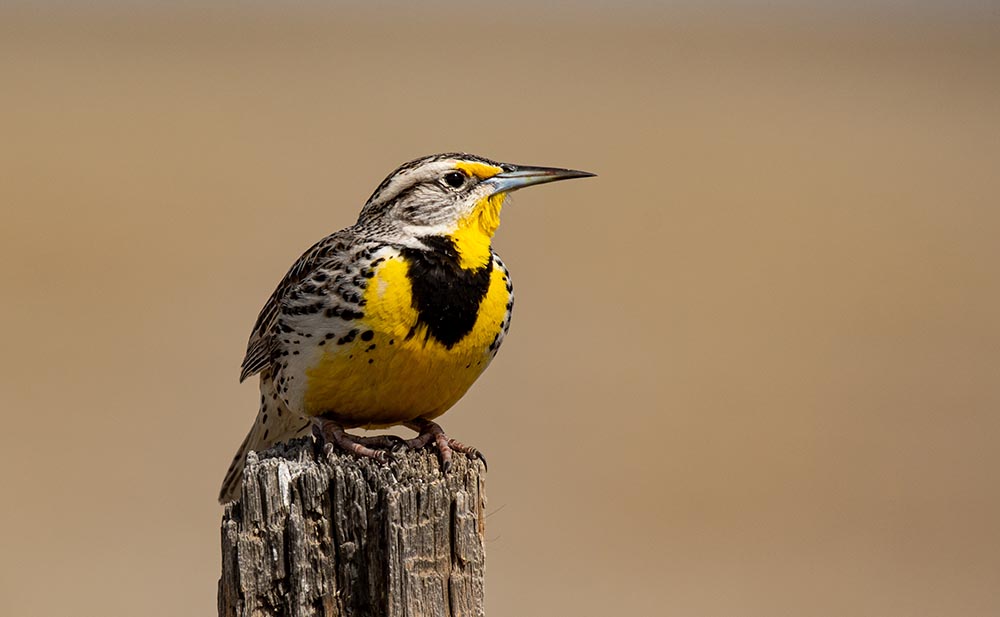
| Scientific Name | Sturnella neglecta |
| Weight | 0.25 pounds |
| Wingspan | 16.1 inches |
| Lifespan | 6 years |
| Diet | Insects and seeds |
The Western Meadowlark is a small, accidental species. Most of their feathers are black and brown, but their underbellies are bright yellow, featuring a distinctive black band across their chest. Another unique feature of this bird’s appearance is that this black band turns gray during the winter.
Western Meadowlarks prefer to nest in meadows, shrubby vegetation, grasslands, fields, and wooded areas. They feed on grain, seeds, and insects while building their nest in the grasslands’ depressions. They fill these depressions with grass and use plant stalks to build a discreet roof.
Their calls are traditional and sweet, consisting of warbles, tweets, and whistles in a rhythmic composition. You may use sunflower seeds and cracked corn to attract a Western Meadowlark to your backyard.
12. Yellow-headed Blackbird
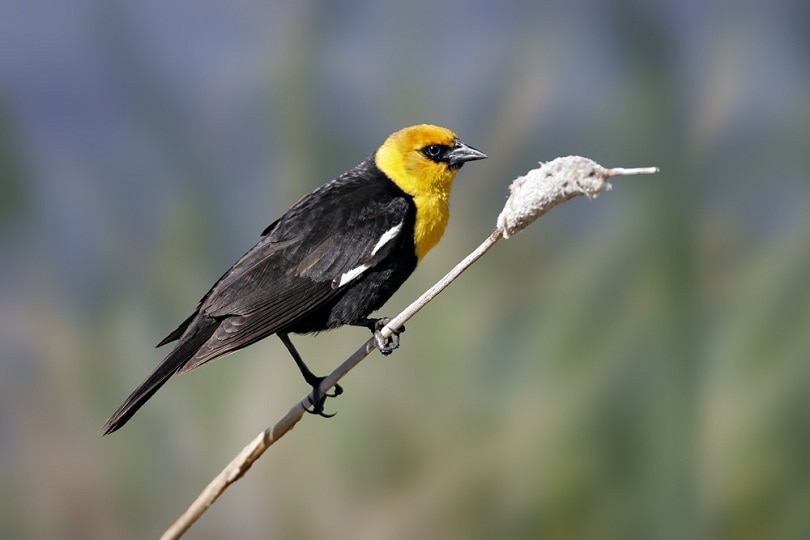
| Scientific Name | Xanthocephalus xanthocephalus |
| Weight | 0.21 pounds |
| Wingspan | 17.3 inches |
| Lifespan | 11 years |
| Diet | Insects and seeds |
The Yellow-headed Blackbird is another small, accidentally occurring species. Its feathers are glossy and black, with a bright yellow patch on the chest and head for the males. The females have a somewhat dull appearance, with brown shades replacing the black areas.
Prairie wetlands, fields, and grasslands are some of the easiest places to spot a Yellow-headed Blackbird, where they feed on any seeds or insects they can find. You can recognize these birds with their distinguishable calls, consisting of a drawn-out screech following a few chirps. In addition, attracting them to your backyard is easy with the help of a bird feeder filled with sunflower seeds.
13. Scott’s Oriole

| Scientific Name | Icterus parisorum |
| Weight | 0.08 pounds |
| Wingspan | 12.6 inches |
| Lifespan | 5 years |
| Diet | Insects, berries, and nectar |
The Scott’s Oriole is another accidental species in Kentucky. Its distinct and vibrant appearance sets it apart from most Orioles, having a black head, black back, and bright yellow underbelly. Its female counterpart is a paler yellow, with an olive-brown back replacing the black areas.
Before spending their breeding season in northern states, Scott’s Orioles prefer spending their winters in southern states such as Kentucky. You’ll typically find these birds on high slopes in arid areas, searching for berries, nectar, and insects. These birds also eat toxic monarch butterflies when needed, tactfully finding the ones with the least toxins.
The male Scott’s Oriole prefers to sing before dawn, delivering articulate, flute-like whistles while perched upon yuccas. Here, they build their nests, 5–10 feet above the ground, using yucca leaves, cactus fibers, and grass. Those that want to attract these birds to their backyard must use jelly, oranges, and sugar water.
14. Bullock’s Oriole

| Scientific Name | Icterus bullockii |
| Weight | 0.09 pounds |
| Wingspan | 12.2 inches |
| Lifespan | 14 years |
| Diet | Insects, fruit, and nectar |
Yet another accidental species, the Bullock’s Oriole, has a bright orange appearance with black and white feathers. The male has distinct markings on its head, while the female has a gray back, yellow head, and overall dull appearance.
In Kentucky, these birds nest in open woodlands and parks, looking for fruits, nectar, and insects. You may leave out fruit, sugar water, or jelly to attract a Bullock’s Oriole to your backyard. Building their nests, made from wool, hair, and grass, takes approximately 15 days for the birds.
You may recognize these birds with their sounds, including cheeps and whistles that last a few moments.
15. Hooded Oriole
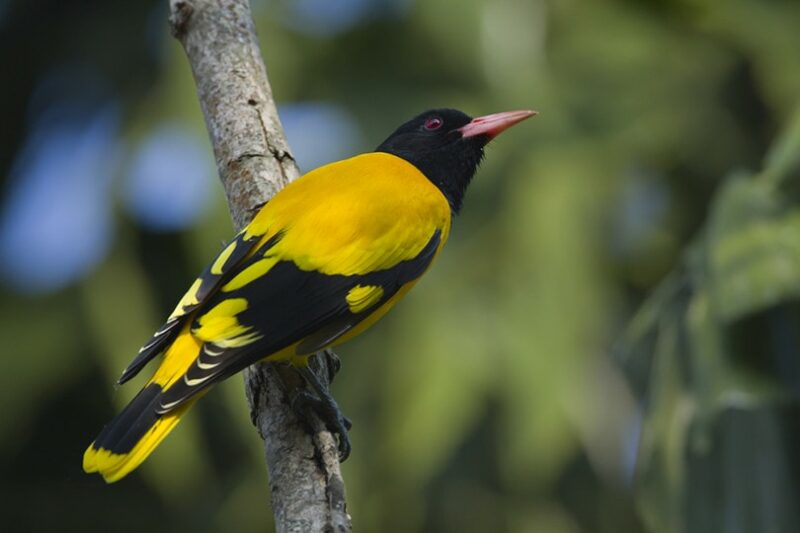
| Scientific Name | Icterus cucullatus |
| Weight | 0.05 pounds |
| Wingspan | 11 inches |
| Lifespan | 5 years |
| Diet | Insects, berries, and nectar |
Lastly, the Hooded Oriole is an accidental and extremely rare species, with its last sighting recorded in 2008. Their feathers are a vibrant combination of orange, black, and yellow, with the males having distinct black face markings.
These birds prefer to breed in southern states such as Kentucky and Mexico. Some even prefer to stay in these states year-round as there’s a ready supply of food available as nectar feeders and fruit. You may find these birds in dry open areas and near palm trees.

Final Thoughts
Now that you know how to recognize the blackbirds in Kentucky with their appearance, behavior, and sounds, you can enhance your birdwatching skills and even attract some to your backyard.
Check out more black birds here:
Featured Image Credit: Jay Gao, Shutterstock
Table of Contents
- 1. European Starling
- 2. Red-winged Blackbird
- 3. Common Grackle
- 4. Brown-headed Cowbird
- 5. Eastern Meadowlark
- 6. Baltimore Oriole
- 7. Orchard Oriole
- 8. Rusty Blackbird
- 9. Bobolink
- 10. Brewer’s Blackbird
- 11. Western Meadowlark
- 12. Yellow-headed Blackbird
- 13. Scott’s Oriole
- 14. Bullock’s Oriole
- 15. Hooded Oriole
- Final Thoughts
About the Author Jeff Weishaupt
Jeff is a tech professional by day, writer, and amateur photographer by night. He's had the privilege of leading software teams for startups to the Fortune 100 over the past two decades. He currently works in the data privacy space. Jeff's amateur photography interests started in 2008 when he got his first DSLR camera, the Canon Rebel. Since then, he's taken tens of thousands of photos. His favorite handheld camera these days is his Google Pixel 6 XL. He loves taking photos of nature and his kids. In 2016, he bought his first drone, the Mavic Pro. Taking photos from the air is an amazing perspective, and he loves to take his drone while traveling.
Related Articles:
Monocular vs Telescope: Differences Explained (With Pictures)
10 Types of Hummingbirds in Arkansas (With Pictures)
8 Types of Hummingbirds in Nebraska (With Pictures)
5 Types of Hummingbirds in Idaho (With Pictures)
3 Types of Hummingbirds in Mississippi (With Pictures)
8 Types of Hummingbirds in Kansas (With Pictures)
5 Types of Hummingbirds in West Virginia (With Pictures)
5 Types of Hummingbirds in Ohio (With Pictures)
